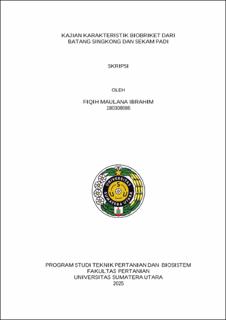Kajian Karakteristik Biobriket dari Batang Singkong dan Sekam Padi
Study of the Characteristics of Biobriquettes from Cassava Stems and Rice Husks

Date
2025Author
Ibrahim, Fiqih Maulana
Advisor(s)
Sigalingging, Riswanti
Metadata
Show full item recordAbstract
Indonesia is one of the agricultural countries that has abundant biomass energy sources. Cassava and rice are one of these energy sources because cassava has biomass energy in its stems and rice in its husks. Biobriquettes are fuels made from biomass through a carbonization process and then compacted using adhesives. The basic ingredients for making these briquettes come from cassava stem waste, rice husks, and tapioca as adhesives. The test carried out was with a non-factorial completely randomized design with parameters of water content, density, ash content and calorific value. From the results of the study, the highest water content was obtained from the P1 treatment of 52,71% and the lowest in the P5 treatment of 37,62%. The highest calorific value in the P3 treatment was 8,303.713 cal/gr and the lowest P5 was 7,996.168 cal/gr. The highest density was obtained in the P5 treatment of 0.672 gr/cm3 and the lowest in the P1 treatment of 0.572 gr/cm3. The highest ash content was in the P5 treatment of 20.24% and the lowest was in the P1 treatment of 6.13%. The highest combustion rate was in the P1 treatment of 0.2713 gr/minute and the lowest was in the P4 treatment of 0.2264 gr/minute. The combination of cassava stems and rice husks on the characteristics of biobriquettes has a very significant effect on water content, density, ash content, combustion rate, but has no significant effect on calorific value.
Collections
- Undergraduate Theses [1082]
